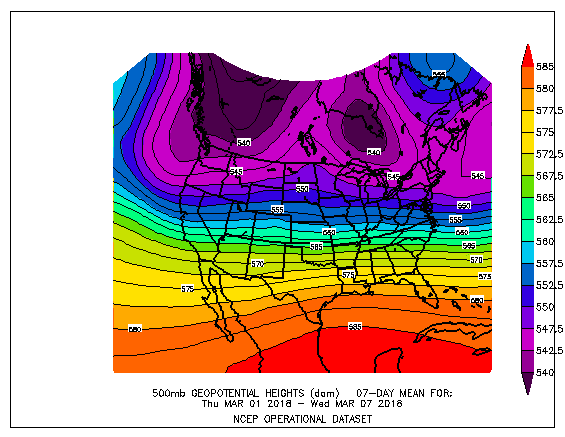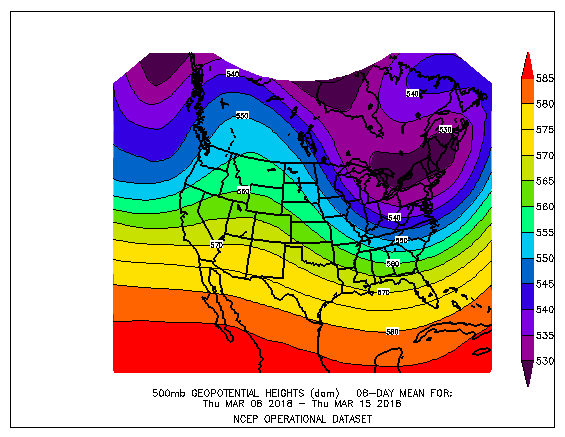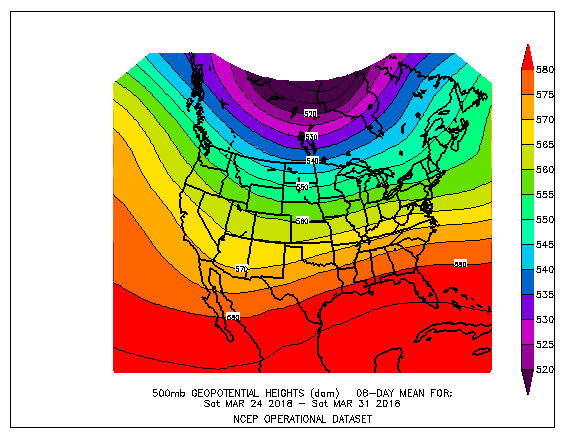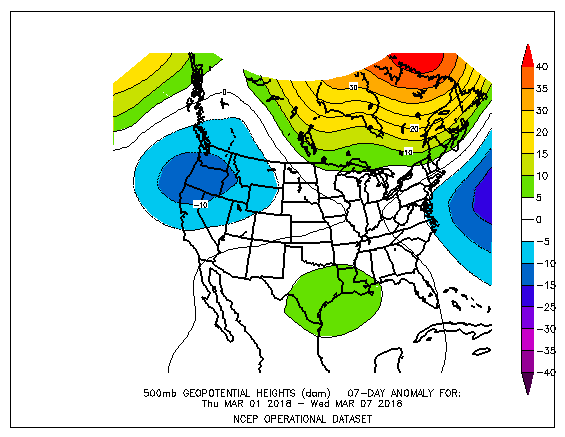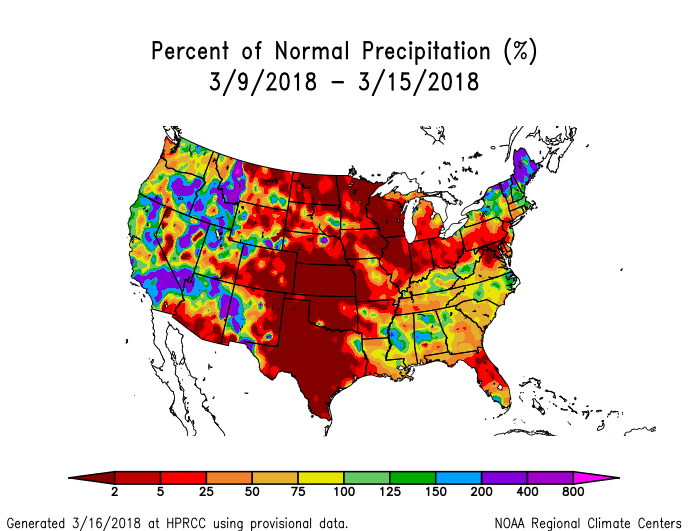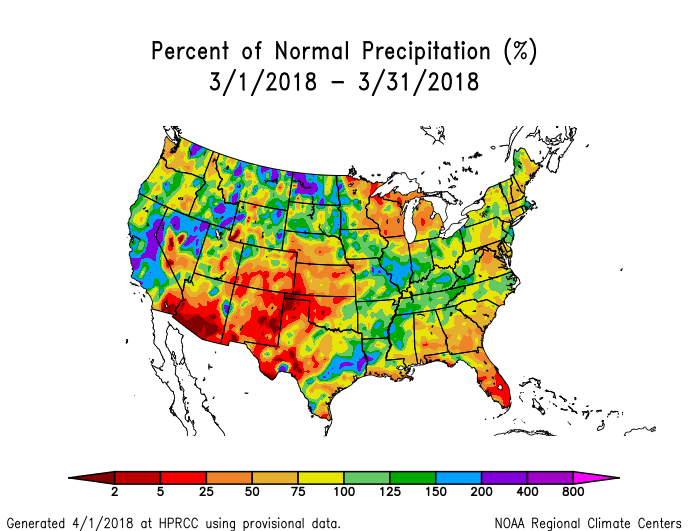Note: This Synoptic Discussion describes recent weather events and climate anomalies in relation to the phenomena that cause the weather. These phenomena include the jet stream, fronts and low pressure systems that bring precipitation, high pressure systems that bring dry weather, and the mechanisms which control these features — such as El Niño, La Niña, and other oceanic and atmospheric drivers (PNA, NAO, AO, and others). The report may contain more technical language than other components of the State of the Climate series.
Summary
The Earth's ocean-atmosphere system continued in a weakening La Niña state during March 2018. Like the last couple months, the upper-level circulation pattern was quite active this month with ridge and trough patterns migrating through the jet stream flow over the contiguous United States (CONUS). The monthly averaged circulation pattern ended up fairly flat, or zonal, with colder-than-normal temperatures spread across much of the CONUS and wetter-than-normal bands across the West, northern Plains, and eastern Texas to Northeast. Above-normal temperatures were centered in the southern Plains and spread into adjacent states, while the storms tracks missed much of the Southwest to central Plains, Southeast, and Great Lakes regions where the month was drier than normal. The persistent dryness led to worsening drought conditions, especially in the Southwest to central Plains and in Florida, where wildfires became a growing problem this month. But drought contraction outpaced expansion, so the national drought footprint shrank a bit when compared to the beginning of March. The active fronts and low pressure systems generated severe weather — but mostly in the southern Plains to Southeast where Gulf of Mexico moisture, warm temperatures, and clashing air masses provided the energy and dynamics. The upper-level circulation, temperature, and precipitation anomaly patterns suggested that the atmospheric drivers originating in the equatorial Pacific (i.e., La Niña and MJO), North Pacific (PNA and EP-NP), North Atlantic (NAO), and Arctic (AO) may have had a controlling influence on the month's weather. See below for details.
Synoptic Discussion
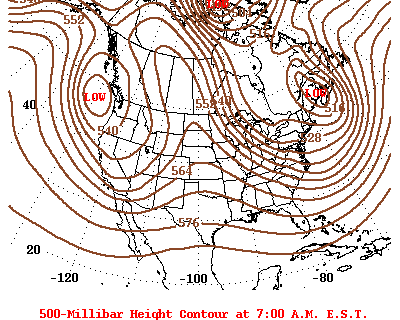 Animation of daily upper-level circulation for the month.
|
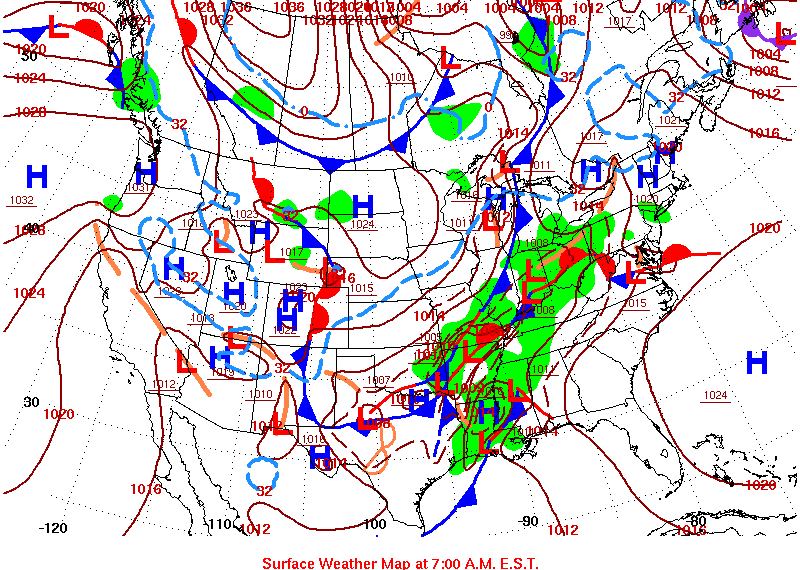 Animation of daily surface fronts and pressure systems for the month.
|
In the Northern Hemisphere, March is the first month of climatological spring, marking the early transition from winter conditions to the warm season. Spring is the time of year when solar heating increases with the rising sun angle, arctic air masses are not as cold, and a contracting circumpolar vortex forces the jet stream northward. Polar air masses influence the weather over the contiguous U.S. (CONUS) less, and the warm, dry subtropical high pressure belts influence the weather more. The result is transient weather patterns are common during March, with (typically) increasingly warm (subtropical) air masses building from the south, typically interrupted by incursions of the cold, and sometimes frigid, polar air.
The upper-level circulation was very active this month with many short-wave troughs and closed lows moving west to east across the CONUS in the westerly jet stream flow. These troughs and closed lows dragged surface lows and fronts with them. Most originated over the Pacific, but some of the fronts pulled in colder Canadian air behind them. The lows tended to favor the west and east coasts, while a ridge tried to establish itself across the central part of the CONUS, but the systems were continually on the move and prevented any "long-wave" pattern to become well established. Nevertheless, the overall circulation can be sub-divided into three or four general periods — March 1-7, 8-15, 16-23, and 24-31. The temperature anomaly patterns for the last two weeks were similar (March 16-23 and 24-31), which might lead one to combine the last two weeks into a last half of the month period (circulation maps for March 16-23, 24-31, and 16-31) , but the circulation and precipitation (March 16-23 vs. 24-31) patterns for the last two weeks were different, which argues against combining them. Each of these patterns was characterized by specific weather phenomena, temperature anomalies, precipitation anomalies, and impacts.
During the first week of March (March 1-7), an upper-level trough was established over the western CONUS with a weak ridge over central North America. The average, or climatological, circulation over North America this time of year is a ridge over the West and a trough over the East. The anomalous trough flattened the climatological ridge in the West and the anomalous ridge over central North America tended to weaken the climatological trough in the East, so the March 1-7, 2018 pattern actually looked like a flat (or "zonal") flow. Pacific weather systems dove into the western trough and brought much-needed above-normal precipitation to parts of the West. They continued on their track eastward, bringing above-normal precipitation to parts of the northern Plains and areas along and east of the Mississippi Valley. This storm track left much of the region from the Southwest to central Plains, and much of the coastal Southeast, drier than normal. The western trough kept temperatures below normal across the West, while the ridge allowed a southerly flow to bring warmer-than-normal temperatures to much of the CONUS east of the Rockies.
The center of action migrated to the east during the second week (March 8-15), allowing the climatological ridge to manifest itself in the West and the trough to become dominant in the East. The eastern trough funneled colder Canadian air masses across the northern Plains and into the Southeast, where temperatures averaged below normal, while the western ridge brought warmer-than-normal temperatures to the West. But the ridge wasn't strong enough to keep Pacific weather systems from penetrating the West, where precipitation was above normal in many areas. The western ridge and associated northwesterly flow across the central CONUS, however, was enough to block Gulf of Mexico moisture and keep much of the Plains and Great Lakes region drier than normal. Low pressure systems that developed along the fronts in the Southeast were able to tap some of the Gulf moisture to bring precipitation to the Lower Mississippi Valley to Mid-Atlantic region. As the lows moved into the new center of action over eastern North America, they intensified into Nor'easters and brought above-normal precipitation to parts of the Northeast.
The circulation during the last half of the month was a free for all, with upper-level troughs and closed lows migrating eastward in the jet stream flow, popping up ridges between them which also migrated with the flow. The net effect, or dominant pattern, during March 16-23 was a ridge across the central CONUS and troughs along the West and East Coasts, while the opposite pattern dominated during the following week.
The central ridge kept temperatures warmer than normal and precipitation drier than normal across much of the Southwest to southern Plains, while the upper-level troughs favored cooler-than-normal air masses over much of the West and Midwest to East Coast. Pacific weather systems intensified as they moved into the western trough, bringing much-needed precipitation to much of the West, while lows were regenerated when they moved into the eastern trough, bringing precipitation to parts of the Southeast to Mid-Atlantic region. One surface low/frontal system was vigorous enough to trigger an outbreak of tornadoes across parts of the Southeast on March 19th. The weather systems were energetic enough to survive the ridge and drop above-normal precipitation as they moved across the central and northern Plains. This northern storm track, combined with a persistent snow cover (snow cover maps for March 1, 8, 14, 19, 25, 31), also kept temperatures cooler-than-normal across the central to northern Plains. With the eastern trough deflecting the storm track a bit to the south, the Great Lakes and much of the Northeast were left drier than normal during this week.
By the end of the last week (March 24-31), a trough became established across central North America, stretching into the northern Plains. A deep upper-level low moving across the CONUS early in the week extended the trough's reach into the Southwest. Ridging stubbornly held on early in the Southeast to southern Plains, keeping temperatures warmer than normal, especially from the Lower Mississippi Valley to New Mexico. Ridging off the West Coast, along with a northwesterly flow over the West Coast, brought cooler-than-normal temperatures to the West but also inhibited the weather systems so that the week ended up drier than normal. The trough sent Canadian air masses into the northern Plains and Midwest, where they brought cooler-than-normal temperatures and managed areas of above-normal precipitation. But the fronts stalled out as they reached the Lower Mississippi to Ohio Valleys, tapping Gulf of Mexico moisture to dump heavy precipitation from Texas to the eastern Great Lakes. One low pressure system developed along the stalled front on the 28th; the atmospheric dynamics, southwesterly flow aloft, temperature contrast, and latent heat energy triggered an outbreak of severe weather and tornadoes that stretched from coastal Texas to Mississippi. With the Texas-to-Great-Lakes storm track locked in place, much of the central Plains and Southeast to coastal Northeast were left drier than normal.
When conditions are averaged across the entire month, a slightly distorted western ridge/eastern trough pattern can be seen, except the western ridge seems shifted to the east a bit with a trough pushing south along the West Coast into the eastern North Pacific. The monthly temperature anomaly pattern reflected the monthly circulation anomaly pattern, with below-normal temperatures along the West Coast into the Great Basin, and in the eastern CONUS east of the Mississippi River. Below-normal temperatures were also found in the northern Plains along the preferred path of Canadian air masses and where the snow cover persisted throughout the month (a persistent snow cover tends to cool the air above it). Above-normal temperatures occurred in the southern Plains beneath the area of above-normal upper-level height anomalies. The precipitation anomaly pattern for the month represented an additive result of the anomaly patterns for the various weeks, with the areas that were much wetter than normal during one or more weeks showing up wet at the monthly time scale, and those areas (especially the Southwest to central Plains, coastal Southeast, and western Great Lakes) that were persistently dry every week showing up as quite dry at the monthly scale. The circulation during this month was also reflected in snow, drought, and regional records.
- The variable circulation this month tended to even out temperature and precipitation extremes on the state level. While some states were warmer or colder than average and some were wetter or drier than average, none ranked in the top ten or bottom ten categories. The closest was North Dakota, which had the eleventh wettest March in the 1895-2018 record.
- When daily temperature records are examined, the extreme warmth and extreme cold essentially balanced each other. When integrated across the month, there were 1,515 record warm daily high (620) and low (895) temperature records. This was about 1.5 times the 1,031 record cold daily high (663) and low (368) temperature records.
- As noted earlier, March is the beginning of the Northern Hemisphere climatological spring, a period of transition from winter cold to the warmer temperatures of summer. Cold outbreaks will increase heating demand, while abnormally warm temperatures will reduce it. Temperatures averaged across the month and across the CONUS gave March 2018 a rank of 49th warmest. The high population centers of the southern Plains were warmer than normal while the high population centers of the East Coast and Midwest were colder than normal, which resulted in a REDTI (Residential Energy Demand Temperature Index) for March 2018 that ranked near the median value (60th highest [coldest], or 65th lowest [warmest]) in the 124-year historical record for March.
- Some of the precipitation fell on drought areas and contracted drought and abnormal dryness, while other drought areas continued quite dry. Drought and abnormal dryness improved in parts of the Plains, California, Pacific Northwest, Alaska, Mid-Mississippi Valley, and interior Southeast to Mid-Atlantic region, but developed, expanded, or intensified across much of the Southwest to southern and central Plains, and parts of the coastal Southeast and western Great Lakes. Contraction outweighed expansion, so at the national level drought shrank from 31.3 percent of the CONUS at the end of February to 29.4 percent of the CONUS at the end of March (from 26.2 percent to 25.0 percent for all of the U.S.). The month began with just a few large wildfires in spotty areas in the Southwest, southern Plains, and Florida. Rains in previous months allowed vegetation to grow, providing fuel for fires during dry periods this month, especially in eastern Oklahoma and western Arkansas. By mid-month, dozens of large wildfires had developed in Florida and the southern Plains, especially eastern Oklahoma. At the end of the month, large wildfires continued to plague the southern Plains and Florida, with more igniting in other parts of the Southeast (wildfire maps for March 1, 19, 24, 28, 31).
- March began with 34.3 percent of the CONUS experiencing a snow cover. The percent area fluctuated between about 30 percent and 38 percent for the first three weeks, as a series of Pacific storm systems paraded across the CONUS, some bringing much-needed snow to the West (snow water content for March 31 vs. February 28), most keeping snow cover across the northern Plains where the air masses were frequently below freezing, and others laying down transient blankets of snow across the Midwest to East Coast where four of them intensified into Nor'easters (snow cover maps for March 1, 8, 13, 19, 23, 25, 31). The migratory nature of the storm systems, during this time of year, advected warm (above-freezing) air ahead of their fronts and cold (below-freezing) air behind them, so as soon as one system passed and blanketed an area with snow, the next system helped erode the snow cover. The exceptions were the northern Plains and (for most of the month) the Northeast, where cold Canadian air masses dominated and temperatures were below freezing long enough, and the snow replenished frequently enough, that a snow cover lasted for much of the month. During the last week of the month, the CONUS snow cover area steadily decreased to about 18 percent as the increasing sun angle and lengthening days continued their seasonal warming of the country.
- The atmospheric circulation needed to create the instability and dynamics favorable for severe weather consists largely of a southwesterly flow across the central part of the CONUS. This upper-level circulation pattern occurred occasionally as short-wave troughs and closed lows moved across the region. Two such instances occurred on March 19th and 28th. The specific synoptic details were discussed earlier. These two tornado outbreaks accounted for most of the (according to preliminary reports) 62 tornadoes that occurred in March 2018. March is usually when the severe weather season begins to ramp up. So, in spite of these outbreaks that occurred this month, the total tornado count for March 2018 was still less than the March average of 80.
Typically tropical cyclone activity is enhanced in the Eastern North Pacific and inhibited in the North Atlantic during El Niños, and inhibited in the Eastern North Pacific and enhanced in the North Atlantic during La Niñas, due mostly to changes in vertical wind shear during the two extreme events. The relationship is unclear during ENSO-neutral events. The tropical Pacific Ocean continued in a La Niña state during March 2018, but the La Niña was weakening.
- The Atlantic hurricane season runs from June 1st through November 30th and the Eastern North Pacific hurricane season runs from May 15th through November 30th. No tropical storms or hurricanes developed in these basins during March 2018. No tropical cyclones formed in, or moved into, the central North Pacific.
- A typhoon and a tropical disturbance developed in the western North Pacific and South Pacific in or near the U.S.-Affiliated Pacific Islands (USAPI). Super Typhoon Jelawat began as a tropical disturbance within USAPI waters near Pohnpei at mid-month. It developed into a Tropical Storm as or soon after it passed between Yap and Koror in the western USAPI. Upon reaching the waters of the Philippine Sea, Jelawat intensified into a Typhoon, briefly reaching Super Typhoon status on the 30th before moving north, rapidly weakening, and passing over the extreme northern Marianas then getting swept up in the mid-latitude westerly circulation as a Subtropical Storm. Another tropical disturbance (Invest 98W) appeared briefly near Chuuk at the end of the month, but quickly dissipated. In the Southern Hemisphere, Severe Tropical Cyclone Hola developed in early March far west of American Samoa, as did Tropical Cyclones Iris later in the month and Josie at the end of the month.
|
March was drier than normal across much of the Southwest to southern and central Plains, Southeast, and Great Lakes region, and parts of the Pacific Northwest and Mid-Atlantic to New England. The month was wetter than normal from California to the northern Plains, and from eastern Texas to the Ohio Valley and southern Appalachians. Alaska and Puerto Rico were drier than normal in the southern portions and near to wetter than normal in the north and west. Hawaii had a mixed precipitation anomaly pattern. |
|
Monthly temperatures were warmer than normal across the southern Plains and adjacent parts of the Southwest and Lower Mississippi Valley, as well as Maine. March was colder than normal across most of the rest of the CONUS. Alaska was mostly warmer than normal, except for a few areas in the south. |
|
Global Linkages: The upper-level (500-mb) circulation anomaly pattern over North America was part of a complex long-wave pattern that stretched across the Northern Hemisphere. Widespread north/south coupling of circulation anomalies is apparent. The above-normal (positive) height anomalies over the Arctic Ocean, Greenland, and northern Canada, coupled with the below-normal height anomalies further south over the northwestern and northeastern CONUS and stretching across the Atlantic and Eurasia, suggests an abnormal displacement of the circumpolar vortex into lower latitudes than is usual for this time of year. The below-normal heights over Eurasia and the Atlantic also seem to be surrounded by above-normal heights further south across northern Africa, extending across Asia and into the North Pacific. The only obvious east/west coupling of height anomalies seems to be over North America. The upper-level circulation and its anomalies are associated with the Sea Level Pressure (SLP) pattern and its anomalies which reflect the semi-permanent centers of action of SLP. The above-normal upper-level height anomalies over the North Pacific appear to be associated with above-normal SLP, indicating a stronger-than-normal North Pacific High and a weaker-than-normal and shifted Aleutian Low compared to climatology. The Aleutian Low might even be split, with one low pressure center of action shifted to the Kamchatka Peninsula and another to the Gulf of Alaska and British Columbia coast. The opposite situation may have happened over the Atlantic and Eurasia. The North Atlantic High seems weaker and shifted to the south, while the Icelandic Low seems stronger and shifted with multiple centers of action (one off the New England/Canadian Maritime coast, another centered over Ireland, and yet a third over the central Siberia/Arctic coastline). The above-normal 500-mb heights were associated with upper-level ridging, or with weakened troughs, at the mid-latitudes; below-normal precipitation (over south central CONUS); below-normal snow cover (over south central CONUS, plus Mongolia and areas in Asia east and west of Mongolia); above-normal surface temperatures (over south central CONUS to Mexico, Alaska, and southwest Asia to China); and warm SST anomalies (in the North Pacific, South Pacific, South Atlantic, and Indian Oceans). The areas of below-normal 500-mb heights were associated with upper-level troughing, or with weakened ridges; near- to below-normal surface temperatures (over much of Europe and along the Siberian coast); a cooling trend in SST anomalies (in parts of the eastern North Pacific and western North Atlantic); above-normal precipitation (over the western CONUS and much of Europe to Russia); and above-normal snow cover (over the western and northeastern CONUS, plus much of Europe). Parts of North America and much of Eurasia were near to cooler than normal, and parts of the equatorial Pacific, South Pacific, South Atlantic, and Indian Ocean had cooler-than-normal SST anomalies. But with parts of northern and southern North America, southern Asia, and much of South America, Australia, and Africa having warmer- to much-warmer-than-normal temperatures, and large portions of the Atlantic, Pacific, and Indian Oceans having warmer-than-normal sea surface temperatures, the March 2018 global temperature was still above normal. |
Atmospheric Drivers
Subtropical highs, and fronts and low pressure systems moving in the mid-latitude storm track flow, are influenced by the broadscale atmospheric circulation. The circulation of the atmosphere can be analyzed and categorized into specific patterns. The Tropics, especially the equatorial Pacific Ocean, provides abundant heat energy which largely drives the world's atmospheric and oceanic circulation. The following describes several of these modes or patterns of the atmospheric circulation, their drivers, the temperature and precipitation patterns (or teleconnections) associated with them, and their index values this month:
-
El Niño Southern Oscillation (ENSO)
- Description: Oceanic and atmospheric conditions in the tropical Pacific Ocean can influence weather across the globe. ENSO is characterized by two extreme modes: El Niño (warmer-than-normal sea surface temperature [SST] anomalies in the tropical Pacific) and La Niña (cooler-than-normal SST anomalies), with the absence of either of these modes termed "ENSO-neutral" conditions.
- Status: La Niña conditions were present during March 2018 with below-average SSTs across the central and eastern equatorial Pacific Ocean, but the La Niña was weakening.
- Teleconnections (influence on weather): To the extent teleconnections are known, the typical temperature and precipitation patterns associated with La Niña during March include above-normal temperatures across parts of Texas to the Southeast; below-normal temperatures across the West and the central to northern Plains to Northeast; near-normal temperatures in between; above-normal precipitation in the Pacific Northwest to northern Rockies and northern California, and from Arkansas to the Northeast; and below-normal precipitation across most of the Southwest, southern to central Plains, and coastal Southeast to Mid-Atlantic region.
- Comparison to Observed: The March 2018 temperature and precipitation anomaly patterns are in very good agreement with the teleconnections for La Niña in most places and in the overall shape of the patterns.
-
Madden-Julian Oscillation (MJO)
- Description: The MJO is a tropical disturbance or "wave" that propagates eastward around the global tropics with a cycle on the order of 30-60 days. It is characterized by regions of enhanced and suppressed tropical rainfall. One of its indices is a phase diagram which illustrates the phase (1-8) and amplitude of the MJO on a daily basis. The MJO is categorized into eight "phases" depending on the pattern of the location and intensity of the regions of enhanced and suppressed tropical rainfall. The MJO can enter periods of little or no activity, when it becomes neutral or incoherent and has little influence on the weather. Overall, the MJO tends to be most active during ENSO-neutral years, and is often absent during moderate-to-strong El Niño and La Niña episodes.
- Status: The MJO Wheeler-Hendon index began the month strongly in phase 3, then became incoherent for much of the month, and ended the month in phase 7. Other aspects of the tropical ocean-atmosphere system (referred to in the CPC reports as the background or low frequency [i.e., La Niña] state, Kelvin and Rossby waves, and tropical cyclone activity) also appeared to play a role in influencing the month's climate (especially Rossby waves and Kelvin waves) (MJO updates for March 5, 12, 19, 26, and April 2).
- Teleconnections (influence on weather): The MJO's temperature and precipitation teleconnections to U.S. weather depend on time of year and MJO phase. To the extent teleconnections are known, the March (February-April) teleconnections for temperature are shown here and for precipitation are shown here.
- Comparison to Observed: The MJO is transitory and can change phases (modes) within a month, so it is usually more closely related to weekly weather patterns than monthly. In the case of March 2018, the MJO precipitation teleconnections for phase 3 have many similarities to the precipitation anomaly patterns for February 25-March 3 and March 4-10, and the precipitation teleconnections for phase 7 have many similarities to the precipitation anomaly pattern for March 25-31. The MJO temperature teleconnections show little resemblance to the observed weekly temperature anomaly patterns, except maybe some agreement in some areas for phase 7 with March 25-31. The monthly precipitation anomaly pattern, being an addition of the weekly patterns, agrees in some areas to the precipitation anomaly patterns associated with the MJO phases experienced this month. The monthly temperature anomaly pattern agrees with phase 3's teleconnections where it is cold, but that may be a coincidence.
- The Pacific/North American (PNA) pattern
- Description: The PNA teleconnection pattern is associated with strong fluctuations in the strength and location of the East Asian jet stream. PNA-related blocking of the jet stream flow in the Pacific can affect weather downstream over North America, especially the West and especially in the winter half of the year.
- Status: The daily PNA index was mostly negative during the month, averaging negative for the month as a whole. The 3-month-averaged index was negative.
- Teleconnections (influence on weather): To the extent teleconnections are known, a negative PNA for this time of year (April on the quarterly teleconnection maps) is associated with above-normal temperatures across the southern and central Plains to East Coast; below-normal temperatures in the Pacific Northwest and across most of Canada to Alaska; above-normal upper-level circulation anomalies over southeastern CONUS to Mexico; below-normal upper-level circulation anomalies over western Canada to the northwest CONUS, and over the Canadian Maritimes; and below-normal precipitation from Utah to Kansas, but there are few precipitation teleconnections.
- Comparison to Observed: The March 2018 monthly upper-level circulation anomaly pattern over North America has some agreement to the teleconnections for a negative PNA, but appears shifted. The monthly temperature anomaly pattern has some agreement in the southern Plains and Pacific Northwest, but not elsewhere. The monthly precipitation anomaly pattern matches where the few teleconnections exist.
- The Arctic Oscillation (AO) pattern
- Description: The AO teleconnection pattern relates upper-level circulation over the Arctic to circulation features over the Northern Hemisphere mid-latitudes and is most active during the cold season.
- Status: The daily AO index was negative for the first two-thirds of the month, then turned positive, averaging negative for the month. The 3-month-averaged index was slightly positive.
- Teleconnections (influence on weather): To the extent teleconnections are known, a negative AO in March (February-April in the AO Composites table) is typically associated with above-normal upper-level circulation anomalies over the Arctic Ocean and Greenland into northern Canada; below-normal upper-level circulation anomalies over the eastern half of the CONUS, across the North Atlantic, and over much of Europe; below-normal temperatures across most of the CONUS; near-normal temperatures along the West Coast; and drier-than-normal conditions from the Ohio Valley to Great Lakes and parts of New England; and wetter-than-normal conditions in Florida.
- Comparison to Observed: The March 2018 monthly upper-level circulation anomaly pattern is a good match for a negative AO across the eastern CONUS, North Atlantic, and Europe, but seems shifted a little over the central CONUS. The monthly temperature anomaly pattern in the CONUS shows good agreement with the teleconnections everywhere except the southern Plains and West Coast. The monthly precipitation anomaly pattern over the CONUS matches agrees over the Great Lakes, but is opposite in the other areas with teleconnections (i.e., Ohio Valley and Florida).
- The North Atlantic Oscillation (NAO) pattern
- Description: The NAO teleconnection pattern relates upper-level circulation over the North Atlantic Ocean to circulation features over the Northern Hemisphere mid-latitudes.
- Status: The daily NAO index started the month negative, but oscillated around zero (neutral) for most of the rest of the month, and averaged negative for the month. The 3-month-averaged index was positive.
- Teleconnections (influence on weather): To the extent teleconnections are known, a positive NAO during this time of year (April on the quarterly teleconnection maps) is associated with below-normal upper-level circulation anomalies over most of the CONUS, extending across the North Atlantic to Western Europe; above-normal circulation anomalies over northern Canada to Greenland; below-normal temperature anomalies for most of the CONUS except the southern Plains to Southeast; and wetter-than-normal precipitation anomalies in California to Nevada, the central Plains, and Southeast, but the precipitation teleconnections are few and weak.
- Comparison to Observed: The March 2018 upper-level circulation overall anomaly pattern is a good match, except it is not as negative over the CONUS. The temperature anomaly pattern agrees across most of the CONUS. The precipitation anomaly pattern agrees with the teleconnections over California, but that may be a coincidence since the precipitation teleconnections are weak and the observed anomalies don't agree over the central Plains or Southeast.
- The West Pacific (WP) pattern
- Description: The WP teleconnection pattern is a primary mode of low-frequency variability over the North Pacific and reflects zonal and meridional variations in the location and intensity of the (East Asian) jet stream in the western Pacific.
- Status: The monthly WP index was positive, as was the three-month average WP index.
- Teleconnections (influence on weather): To the extent teleconnections are known, a positive WP during this time of year (April on the quarterly teleconnection maps) is typically associated with above-normal temperatures from western Canada to the Ohio Valley; below-normal temperatures in the Southwest; near-normal temperatures elsewhere; above-normal circulation anomalies western Canada to the northern Plains; below-normal circulation anomalies over the southwestern CONUS; and below-normal precipitation Washington State, although there are few teleconnections.
- Comparison to Observed: The March 2018 monthly temperature anomaly pattern shows little agreement with the teleconnections for a positive WP. The upper-level circulation anomaly pattern shows some agreement, but it seems shifted. The precipitation anomaly pattern is a very good match for the one region where teleconnections exist.
- The East Pacific-North Pacific (EP-NP) pattern
- Description: The EP-NP teleconnection pattern relates SST and upper-level circulation patterns (geopotential height anomalies) over the eastern and northern Pacific to temperature, precipitation, and circulation anomalies downstream over North America. Its influence during the winter is not as strong as during the other three seasons.
- Status: During March 2018, North Pacific SSTs warmed in the lower latitudes and cooled in higher latitudes, resulting in little change in the overall SST anomaly pattern. The March 2018 monthly EP-NP index was slightly positive, with the 3-month running mean slightly positive.
- Teleconnections (influence on weather): To the extent teleconnections are known, a positive EP-NP index this time of year (April on the quarterly teleconnection maps) is typically associated with cooler-than-normal temperatures across the CONUS from the Great Plains to East Coast (except the Southeast) and across central to eastern Canada; above-normal temperatures over Alaska; above-normal upper-level circulation anomalies (stronger upper-level ridge) over Alaska and western Canada; and below-normal upper-level circulation anomalies across central to eastern North America (stronger upper-level trough) and over the central North Pacific. The precipitation teleconnections are weak but suggest wetter-than-normal conditions over Wyoming and the Midwest.
- Comparison to Observed: The March 2018 monthly temperature anomaly pattern agrees with the teleconnections associated with a positive EP-NP where teleconnections exist across the Plains to East Coast. The upper-level circulation anomaly pattern shows little agreement. The monthly precipitation anomaly pattern generally agrees where the few teleconnections exist.
| Week | Temperature | Precipitation |
| Feb 25-Mar 3 | — | MJO |
| March 4-10 | — | MJO |
| March 11-17 | — | — |
| March 18-24 | — | — |
| March 25-31 | MJO | MJO |
Examination of the available circulation indices and their teleconnection patterns, and comparison to observed March 2018 weekly and monthly temperature, precipitation, and circulation anomaly patterns, suggest that the weather over the CONUS in March was influenced by a variety of equatorial and mid-latitude atmospheric drivers, possibly acting in concert. The WP teleconnections bore little resemblance to the observed anomaly patterns, so the driver behind this index did not appear to be a player this month. The AO and NAO teleconnections for atmospheric circulation (500-mb heights) were strongly correlated with negative heights across most of the CONUS, but the PNA teleconnections had positive heights in the south. The combination of these teleconnections could explain the observed monthly circulation anomaly pattern. The AO and EP-NP had cold teleconnections across the central and eastern CONUS, while the NAO and La Niña were cold in the western CONUS and central to northeastern CONUS but neutral or warm in the southern Plains and Southeast. The combination of these teleconnections could explain the observed monthly temperature anomaly pattern. Precipitation is a less coherent climate variable than temperature or atmospheric circulation (500-mb height), but even so, the observed precipitation pattern could be related to the forcings behind the La Niña, MJO, and maybe even PNA.
This month illustrates how the atmospheric circulation for the month can reflect several atmospheric drivers (or modes of atmospheric variability) in a way that the drivers in the equatorial Pacific, North Pacific, North Atlantic, and Arctic Ocean appear to complement each other.
 NOAA's National Centers for Environmental Information
NOAA's National Centers for Environmental Information
